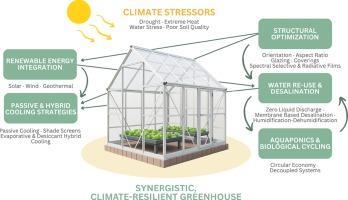迈向资源智慧型温室:旱地的远景展望
IF 7.9
Q1 ENGINEERING, MULTIDISCIPLINARY
引用次数: 0
摘要
在极端温度、干旱和土壤质量差限制了传统粮食生产的干旱地区,温室农业提供了一种有希望的替代露天种植的方法。然而,现有的温室系统通常是为温带气候设计的,难以应对干旱地区(包括干旱、半干旱和地中海地区)特有的热和水力压力。这篇前瞻性综述提出了气候适应型温室设计的系统级框架,强调了结构优化、被动和混合冷却策略、先进的玻璃材料、脱盐水再利用和基于水培的生物循环的整合。关键的杠杆点包括方向驱动的热缓解,可再生能源驱动的膜基海水淡化,以及分离的水共生系统,这些系统可以实现精确的气候智能方法来控制环境。在蒸发和干燥剂混合冷却、光谱选择和辐射膜以及营养选择电渗析方面的新兴创新进一步增强了集成解决方案的潜力。本文强调了如何协调材料科学、热流体动力学和工程学,以提高干旱环境下温室生产的作物生产力、资源效率和气候适应性。与其将冷却、灌溉和生物生产视为离散的挑战,该综述提倡相互依赖的子系统设计,在统一的生物气候包膜内关闭热、水和营养循环。一个循环概念框架说明了这些协同作用,并指导未来在水资源和能源紧张的旱地的温室发展。通过将温室改造为可再生的基础设施,本研究勾勒出了一个能够在世界上最脆弱的农业区有效和可持续地运作的综合粮食-水-能源联系的蓝图。本文章由计算机程序翻译,如有差异,请以英文原文为准。

Toward resource-intelligent greenhouses: A prospective vision for drylands
Greenhouse agriculture offers a promising alternative to open-field cultivation in dryland regions, where extreme temperatures, drought, and poor soil quality restrict conventional food production. However, existing greenhouse systems, often designed for temperate climates, struggle to cope with the thermal and hydric stresses that characterize dryland environments, including arid, semi-arid, and Mediterranean zones. This prospective review presents a systems-level framework for climate-resilient greenhouse design, emphasizing the integration of structural optimization, passive and hybrid cooling strategies, advanced glazing materials, desalination-enabled water reuse, and aquaponics-based biological cycling. Key leverage points include orientation-driven thermal mitigation, membrane-based desalination powered by renewable energy, and decoupled aquaponics systems enabling a precise and climate-smart approach to environmental control. Emerging innovations in evaporative and desiccant hybrid cooling, spectral selective and radiative films, and nutrient-selective electrodialysis further enhance the potential of integrated solutions. The paper highlights how materials science, thermofluid dynamics, and engineering can be harmonized to improve crop productivity, resource efficiency, and climate adaptability in greenhouse production for dryland settings. Rather than viewing cooling, irrigation, and biological production as discrete challenges, the review advocates for interdependent subsystem designs that close thermal, hydric, and nutrient loops within a unified bioclimatic envelope. A circular conceptual framework illustrates these synergies and guides future greenhouse development in water and energy-stressed drylands. By reframing the greenhouse as a regenerative infrastructure, this study outlines a blueprint for an integrated food–water–energy nexus able to operate efficiently and sustainably in the world's most vulnerable agricultural zones.
求助全文
通过发布文献求助,成功后即可免费获取论文全文。
去求助
来源期刊

Results in Engineering
Engineering-Engineering (all)
CiteScore
5.80
自引率
34.00%
发文量
441
审稿时长
47 days
 求助内容:
求助内容: 应助结果提醒方式:
应助结果提醒方式:


